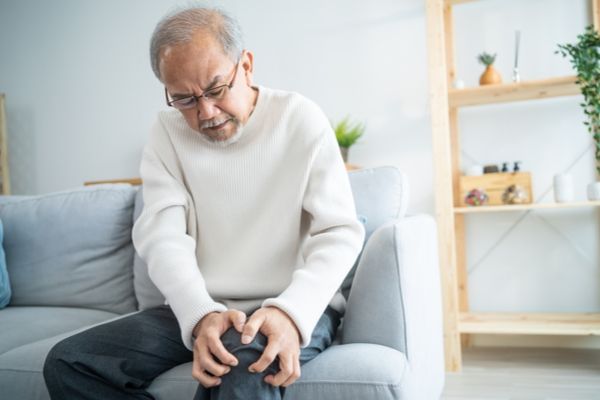Understanding the common symptoms of knee arthritis
Author Details
Reg. PT., M.Sc.PT., H.B.K. | National Director of Program Development, Specialty Services

If you are dealing with or suspect you may have arthritis, you are not alone. It is the most common form of joint condition, affecting approximately 302 million individuals worldwide. The knee is the most commonly affected joint.
Some of the most common symptoms those with knee arthritis experience are: clicking or other noises with movements, knee pain that increases with activity such as climbing stairs or walking, and knee stiffness after sitting or resting.
What are some of the most common symptoms?
Clicking
Clicking in the knee is often thought to be worrisome. However, according to research, knee clicking is very common. In fact, the majority of the population has knees that make some sort of sound!
In many cases, patients visit our clinics with the concern that their knee is clicking. In most cases, the noise is physiological (meaning a natural occurrence). You may be asking, what causes that sound to occur?
The origin of the noise varies from individual to individual and may be due to a buildup of tiny bubbles in joint fluid or ligaments/muscles moving over bone, both of which are normal.
However, if the clicking or noise is painful, it is important to discuss this with a healthcare provider, as this could be a sign of a knee condition. Overall, if your knee is clicking but the clicking is not accompanied by pain, you likely just have noisy knees like most of the population!
Knee pain
Not everyone with knee arthritis experiences pain, but pain is usually the key reason for visits to a healthcare professional. Pain has multiple contributing factors, some of which we tend not to even consider.
One factor may be an issue with the knee membrane (the synovium) that produces lubricating fluid, while another may be due to weakened muscles around the knee. Even our thoughts and feelings can contribute to knee pain.
Everyone has some degree of cartilage degeneration as they get older. If it gets to a point where it causes pain, it is time to seek support from a healthcare professional. A common myth associated with knee arthritis is that activities such as walking, biking and recreational sports will make arthritis worse.
If you stopped doing all of these things, not only would you have stopped doing what you love, you would also experience weakening of the supporting structures around your knees because of reduced use.
Research has shown that exercise promotes blood flow to the knee, providing oxygen and nutrients to enhance the production of lubricating fluid, which may reduce pain. Exercise also has been shown to reduce the sensitivity of pain receptors in your knee overtime through the release of hormones, which can allow you to enjoy the activities you like doing.
Finding the right type of exercise that you enjoy is key in managing your knee arthritis and is something that a physiotherapist can help you with. Here is another article you can check out with some ideas on water-based exercises.
Knee stiffness
You may feel that after some time sitting or upon waking up in the morning that your knee is stiff but that the stiffness often improves with movement and generally lasts for less than 30 minutes. Stiffness in arthritis occurs due to the decrease in production of fluid, which acts to lubricate our joints, like oil to an engine.
With a decrease in this lubricating fluid, joints feel stiff. Managing stiffness can be done from the comfort of your home. Exercise encourages the circulation of lubricating fluid, which will enhance movement. Gentle exercises such as bending and straightening your knee 10-12 times before getting up or performing mini squats upon standing, can help to reduce stiffness following a period of rest and allow you to get on with your day.
Heat therapy, such as a hot pack for ten to fifteen minutes, may also be beneficial when feeling stiff, as it has been shown to help reduce stiffness and promote muscle relaxation. It is important to note that one should not apply any heat products in areas with reduced sensation or if one experiences skin conditions that may be aggravated with heat. Read this blog for more suggestions on how to live well with osteoarthritis.
Living with arthritis may seem overwhelming, however it is important to remember that you are not alone and that there are strategies like the ones mentioned above that can help decrease challenges and allow you to live the life you please.
For more information or if you’d like to schedule an appointment with a physiotherapist, check out our locations page to find a clinic near you or book online.
This blog was written by Walee Malik, a physiotherapy student at the University of Toronto.
Author Details
Reg. PT., M.Sc.PT., H.B.K. | National Director of Program Development, Specialty Services
We can help you move and feel better.
Book an appointment today.